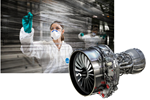Safran invests over €1 billion to develop LEAP engine MRO network
The engine-maker is scaling up global MRO capabilities with several facility builds and company acquisitions to keep pace with expected demand in the narrowbody aircraft market.
Safran Aircraft Engines (Paris, France) has announced an investment plan of more than €1 billion for the development of its global maintenance, repair and overhaul (MRO) network to support the growing fleet of composites-intensive LEAP engines around the world.
This investment will expand Safran’s MRO capabilities, enabling it to support the anticipated ramp-up in demand for LEAP aftersales services in the coming years. The LEAP is the latest engine developed by CFM International, a joint venture between Safran Aircraft Engines and GE Aerospace. It entered service in 2016 and today powers nearly 4,000 narrowbody aircraft, including most new-generation Airbus A320neo, Boeing 737 Max and COMAC C919 airliners. An Aviation Week report on the same subject says that Safran expects this number to double by 2030.
“The expansion of our global LEAP MRO network is in response to the tremendous success of this engine, which has been chosen by some 180 airlines around the world,” says Jean-Paul Alary, CEO of Safran Aircraft Engines. “To ensure we keep pace with the expected increase in demand for aftersales support, we’re radically scaling up our global MRO network. It will be significantly expanded globally, allowing us to provide services where customers need them, while minimizing the carbon footprint from our activities.”
These latest investments will enable Safran Aircraft Engines to handle 1,200 shop visits per year by 2028. This capital outlay will cover the construction of an additional 120,000 square meters of industrial facilities dedicated to LEAP repair and maintenance, including:
- A new site in Brussels, Belgium, which came on stream in early 2024.
- A new facility in Hyderabad, India, which will enter service in 2025.
- A second MRO shop in Querétaro, Mexico, and a new test platform, both of which will begin operations in 2026.
- A new facility in Casablanca, Morocco, slated to enter service in 2026.
- Expansion of the company’s Villaroche and Saint-Quentin-en-Yvelines facilities in France, scheduled for 2025 and 2026, respectively.
The investment plan also encompasses the development of the company’s global engine part repairs network, including:
- A turbine blade repair facility in Rennes, France.
- Expansion of its MRO shop in Querétaro, Mexico.
- Contemplated acquisition of Component Repair Technologies.
To support the expansion of its MRO network, Safran Aircraft Engines plans to hire 4,000 people worldwide and forge local learning and academic partnerships to ensure the upskilling of staff across its MRO organization.
“People are at the heart of this major expansion,” said Nicolas Potier, Executive VP, Support & Services at Safran Aircraft Engines. “That’s why we’ve launched an ambitious training plan aimed at fostering an international network spanning all the job fields involved in MRO,” he added.
Nicolas Potier, executive VP, support and services at Safran Aircraft Engines, believes that by “developing synergies among our MRO facilities, which are also located close to our other industrial sites, we’ll be optimally positioned to achieve quality, safety and industrial performance, while reducing our carbon footprint.”
Related Content
-
Plant tour: Joby Aviation, Marina, Calif., U.S.
As the advanced air mobility market begins to take shape, market leader Joby Aviation works to industrialize composites manufacturing for its first-generation, composites-intensive, all-electric air taxi.
-
Composites manufacturing for general aviation aircraft
General aviation, certified and experimental, has increasingly embraced composites over the decades, a path further driven by leveraged innovation in materials and processes and the evolving AAM market.
-
Plant tour: Albany Engineered Composites, Rochester, N.H., U.S.
Efficient, high-quality, well-controlled composites manufacturing at volume is the mantra for this 3D weaving specialist.

















